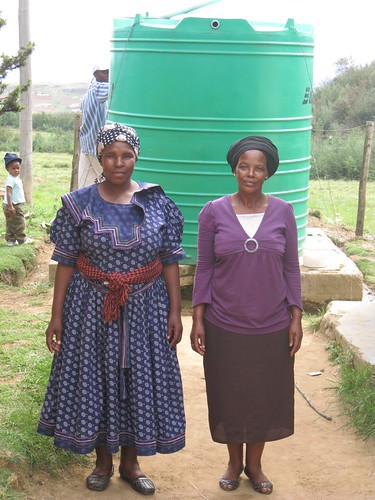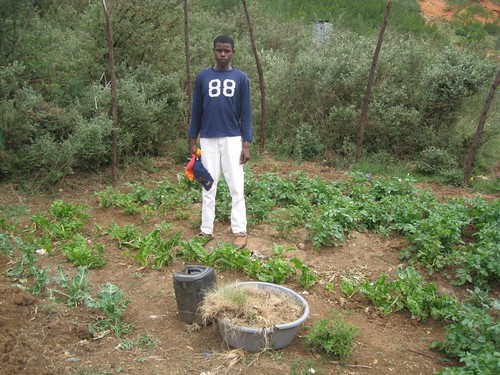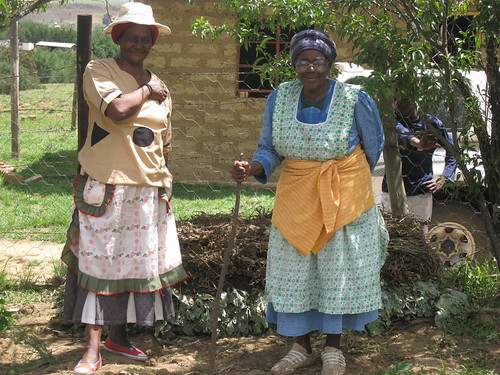This post is the last of three describing a visit we made to a drop in center. Part One, Part Two.
The Village Health Workers
There were about five village health workers (VHWs) there. They told us how their training has changed their lives – for example the social work training showed them the need to care for everyone in their community, not just their family members.
Doris told how she lives with six orphans and cooks for many more. Her permaculture garden is thriving and she has five HIV+ patients who are all on anti-retroviral drugs (ARVs).

Two Village Health Workers
Beatrice has helped the child-headed families and orphans in her area to get the social grants they are entitled to.
Another VHW cooks for 15 orphans and vulnerable children at the local preschool and another nine older children in the area. I’ve met her before – she lives with five young grandchildren in a cramped mud-brick home, yet she still finds the time and energy to help others.
The People Living With AIDS
One man, who looked around 35 or so, stood to say he is sick (HIV+) and Leticia has helped him by taking him to the clinic and providing him with food from her garden. He was grateful for all the help she gives him.
Another man stood to say he could barely talk about his situation, but Leticia’s health care was very important to him. Tears welled as he told us he was sick – we learned as he sat down that he has only just learned he is HIV positive. We told him that with good nutrition and health care, and with proper use of ARVs, he would be able to live a long life. We told the men that many people in the US and UK are living with AIDS and that they are not getting sick thanks to ARVs. Often people here are surprised to learn that people in developed countries have HIV/AIDS and we always try to explain that it is a disease like many others and needs to be treated not stigmatized.
A young woman told us outright that she is HIV+. She was being very brave – most people here will not admit their status like that. She told us how she had gone to the clinic with Leticia, but her CD4 count was too high (at 54) to qualify for ARV treatment at the time. Leticia has been providing her with vegetables and she is helping in the garden and with cooking for the children. Thanks to the improvement in nutrition and general welfare her CD4 count is now over 200 and she feels fit and strong. She said that if not for Leticia, she would be in the ground by now.
The Children and Elderly
A boy of 16 from a child-headed family told us about how Leticia has helped him with food parcels and vegetables from her garden. He has been helping her in the garden and was so inspired that he started his own. Hlomelikusasa has provided him with a fence, some tools, and soon he will receive full permaculture training from us. He told us later that he wants to become a pilot.
One girl came to thank us for the nutrition and help with her school uniform. She reminded us that she will need a new uniform next year when she starts high school! She had written a touching note to Priscilla and showed us the memory box she has with photos of her parents inside.
Another girl thanked us for the nutrition and care she receives at Leticia’s, and also mentioned having enjoyed the art workshop Alex and I did with her last month.
One woman stood to thank Leticia for her help with the elderly. She broke down as she described her elderly mother, who is often left alone at home. She said she sees Leticia visiting her mother and taking vegetables to her, even though she was never asked to do so. She was overcome with tears. I felt emotional myself, looking around at the inspiring and friendly faces. I started to feel a pang that I’m going to leave this behind next year when we go home. It feels a lot like how we felt when we left New York in July.


